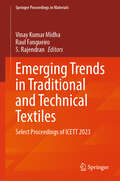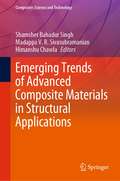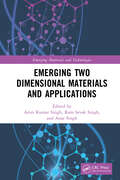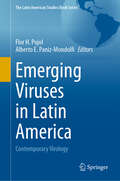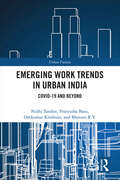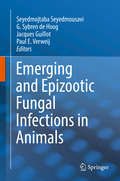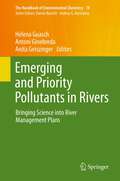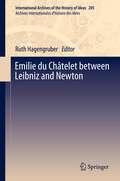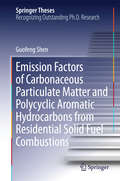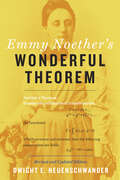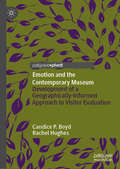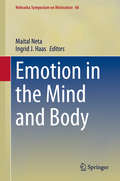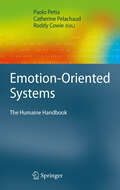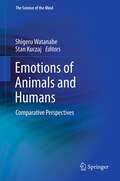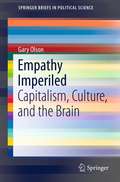- Table View
- List View
Emerging Trends in Terahertz Solid-State Physics and Devices: Sources, Detectors, Advanced Materials, and Light-matter Interactions
by Amit Banerjee Arindam Biswas Aritra Acharyya Hiroshi Inokawa Jintendra Nath RoyThis book highlights recent advances and applications in terahertz (THz) technology, addressing advanced topics such as THz biomedical imaging, pattern recognition and tomographic reconstruction for THz biomedical imaging by machine learning and artificial intelligence, THz imaging radars for autonomous vehicle applications, and THz imaging systems for security and surveillance. It also discusses theoretical, experimental, established and validated empirical work on these topics.
Emerging Trends in Traditional and Technical Textiles: Select Proceedings of ICETT 2023 (Springer Proceedings in Materials #55)
by Raul Fangueiro S. Rajendran Vinay Kumar MidhaThis book presents the select proceedings of the 3rd International Conference on Emerging Trends in Traditional and Technical Textiles (ICETT 2023) and examines the latest developments and applications in the field of textile materials, with a special focus on technical textiles. The topics covered include geotextiles, medical and healthcare textiles, protective textiles, thermal behavior of textiles, functional finishing of textiles, composites and green textiles. The book also discusses the dyeing, printing and fastness properties of the textile materials. This book is a valuable reference for researchers and professionals working in traditional textile design and technical textile applications.
Emerging Trends of Advanced Composite Materials in Structural Applications (Composites Science and Technology)
by Shamsher Bahadur Singh Madappa V. R. Sivasubramanian Himanshu ChawlaThis book introduces different advanced composite materials used in construction of civil engineering infrastructures. It reflects the latest manufacturing processes and applications in the civil structures. This book also includes test cases and its validation with finite element method using computer software. Moreover, the book also deals with design methodology of advanced composite materials based on different applications. The comprehensive overview of the state-of-the-art research on the composite materials presented herein is of interest to scientists, researchers, students and engineers, and practitioners in general working in area of innovative composite materials and structures. This book is also helpful for Ph.D. research scholars for developing their fundamental understanding on advanced materials, and it is also appropriate for master and undergraduate level courses on composite materials.
Emerging Two Dimensional Materials and Applications (Emerging Materials and Technologies)
by Arun Kumar Singh Ram Sevak Singh Anar SinghThis book details 2D nanomaterials, and their important applications—including recent developments and related scalable technologies crucial to addressing strong societal demands of energy, environmental protection, and worldwide health concerns—are systematically documented. It covers syntheses and structures of various 2D materials, electrical transport in graphene, and different properties in detail. Applications in important areas of energy harvesting, energy storage, environmental monitoring, and biosensing and health care are elaborated. Features: Facilitates good understanding of concepts of emerging 2D materials and its applications. Covers details of highly sensitive sensors using 2D materials for environmental monitoring. Outlines the role of 2D materials in improvement of energy harvesting and storage. Details application in biosensing and health care for the realization of next-generation biotechnologies for personalized health monitoring and so forth. Provides exclusive coverage of inorganic 2D MXenes compounds. This book is aimed at graduate students and researchers in materials science and engineering, nanoscience and nanotechnology, and electrical engineering.
Emerging Viruses in Latin America: Contemporary Virology (The Latin American Studies Book Series)
by Flor H. Pujol Alberto E. Paniz-MondolfiLatin America has extensive microbial diversity and is endemic for a wide array of infectious agents including dengue, chikungunya, malaria and tuberculosis. In 2014, the WHO cited 93 public health events of potential international concern in the Latin American region where over half (47 events) were caused specifically by chikungunya and other zoonotic pathogens, causing geographically widespread impact affecting 27 countries and territories. Arena, alpha and flaviviruses are RNA viruses, many of which are endemic in South America, are diverse in nature, and can adapt easily to new hosts, creating zoonotic threats. Since more than 70% of emerging diseases are caused by zoonotic agents, it is of great importance to enhance the capacity for detection and diagnosis in the areas where they are most likely to emerge. COVID-19 provided an opportunity to reinforce public health capacities, improve reporting transparency, and enhance regional coordination. Limited but consistent research has been carried out in the region to address the viral threats that account for a significant portion of health concerns. This book describes relevant examples of these achievements and discusses ongoing limitations in the region.
Emerging Work Trends in Urban India: COVID-19 and Beyond (Urban Futures)
by Nidhi Tandon Pratyusha Basu Omkumar Krishnan Bhavani R.V.This book offers an overview of India’s emerging digital economy and the resulting challenges and opportunities for urban workplaces. It examines contemporary economic and social transformations in India by focusing on how new technologies and policies are shaping urban work practices and patterns. The book emphasizes inclusive and equitable practices that consider the needs of the formal and informal sector workforce as essential to India’s urban development. Drawing on cross-disciplinary frameworks, it examines key issues related to work trends in the Indian urban economy and its digital landscapes, including Industry 4.0 and technology–labour nexus, smart cities and innovation, urbanism and consumerism, workplace transitions such as service industry and remote work, digital divide, skill development initiatives, and the impact of socio-economic inequalities and disruptions. The authors provide perspectives on the digital future of urban work in India and other emerging economies in the post-COVID-19 phase, and underscore the importance of enacting balanced policies, remodelling institutions, and equipping the labour force for adapting to new demands related to future employability and investments. This book will interest students, teachers, and researchers of urban studies, urban sociology, sociology of work, labour studies, human and urban geography, economic geography, urban economics, development studies, urban development and planning, public policy, regional planning, politics of urban development, social and cultural change, urban sustainability, environmental studies, management studies, South Asian Studies, and Global South studies. It will also be useful to policymakers, non-governmental organizations, activists, and those interested in India and the future of the global economy.
Emerging and Eco-Friendly Approaches for Waste Management
by Ram Naresh Bharagava Pankaj ChowdharyRapid industrialization is a serious concern in the context of a healthy environment. With the growth in the number of industries, the waste generated is also growing exponentially. The various chemical processes operating in the manufacturing industry generate a large number of by-products, which are largely harmful and toxic pollutants and are generally discharged into the natural water bodies. Once the pollutants enter the environment, they are taken up by different life forms, and because of bio-magnification, they affect the entire food chain and have severe adverse effects on all life forms, including on human health. Although, various physico-chemical and biological approaches are available for the removal of toxic pollutants, unfortunately these are often ineffective and traditional clean up practices are inefficient. Biological approaches utilizing microorganisms (bacterial/fungi/algae), green plants or their enzymes to degrade or detoxify environmental pollutants such as endocrine disruptors, toxic metals, pesticides, dyes, petroleum hydrocarbons and phenolic compounds, offer eco- friendly approaches. Such eco-friendly approaches are often more effective than traditional practices, and are safe for both industry workers as well as environment. This book provides a comprehensive overview of various toxic environmental pollutants from a variety natural and anthropogenic sources, their toxicological effects on the environment, humans, animals and plants as well as their biodegradation and bioremediation using emerging and eco-friendly approaches (e.g. Anammox technology, advanced oxidation processes, membrane bioreactors, membrane processes, GMOs), microbial degradation (e.g. bacteria, fungi, algae), phytoremediation, biotechnology and nanobiotechnology. Offering fundamental and advanced information on environmental problems, challenges and bioremediation approaches used for the remediation of contaminated sites, it is a valuable resource for students, scientists and researchers engaged in microbiology, biotechnology and environmental sciences.
Emerging and Epizootic Fungal Infections in Animals
by Seyedmojtaba Seyedmousavi G. Sybren de Hoog Jacques Guillot Paul E. VerweijThis book provides in-depth insights into epidemic and emerging mycoses in various animal groups. The different categories of pathogens and outbreak fungi are discussed. In an introductory chapter, the reader will be provided basic information on fungal infections that are non-transmissible, infections from a common environmental source known as sapronoses, and zoophilic fungal pathogens in various animal species and populations, worldwideChapter 2 details the vocabulary and terminology that is required in the scientific literature in order to maintain clarity of expression to the field of Mycology. Chapters 3 to 9 discuss epidemic mycoses with a reservoir in animals and occasional outbreaks, including dermatophytoses, coccidioidomycosis, histoplasmosis, paracoccidioidomycosis, adiaspiromycosis and similar diseases, blastomycosis, and paracoccidioidomycosis ceti (lacaziosis/lobomycosis). Chapters 10 to 15 comprise emerging mycoses in animals that include feline sporotrichosis, lethargic crab disease, emergence of C. gattii in animals and zoonotic potential, white-nose syndrome in hibernating bats, chytridiomycosis in frogs and salamanders and aspergillosis in cats. The last chapter is about treatment possibilities, antifungal use in veterinary practice, and emergence of resistance. The book will address medical and veterinary mycologists, microbiologists, veterinarians, infectious disease specialists, epidemiologists, ecologists, public health scientists from academia and industry as well as graduate students, PhD students and postdocs in the field.
Emerging and Priority Pollutants in Rivers
by Helena Guasch Antoni Ginebreda Anita GeiszingerThe enduring changes in the aquatic environment and the increasing influx of contaminants call for novel conceptual and methodological approaches to relating chemical pollution and ecological alterations in ecosystems. This volume highlights the latest advances concerning the sampling, analyses, occurrence, bioavailability, and effects of emerging and priority pollutants in European rivers, the current status of the River Management Plans in Europe, and the applicability of the newly developed techniques for water monitoring purposes. The topics are discussed in the context of the EU Water Framework Directive, evaluating their shortcomings and providing a basis for doing away with them. Linking scientific research and river management practices, this book is an invaluable source of information for environmental chemists, aquatic scientists, ecologists and water managers.
Emil Fischer’s ‘’From My Life’’: English Translation of ‘’Aus Meinem Leben’’ (Springer Biographies)
by David M. Behrman Edward J. BehrmanThis book is a translation of Emil Fischer’s autobiography published in 1922 by Verlag von Julius Springer, Berlin, Germany. It is the first translation of this work into English, guiding the reader through the life of a man who was one of the greatest chemists of all time. Emil Fischer published very important papers on sugars, purines, and peptides. His proof of the stereo chemistry of glucose remains one of the great intellectual and practical achievements of science. The book is of great benefit to the current and future generations of chemists, giving them the chance to get to know Emil Fischer's life story.
Emil du Bois-Reymond: Neuroscience, Self, and Society in Nineteenth-Century Germany (Transformations: Studies in the History of Science and Technology)
by Gabriel FinkelsteinA biography of an important but largely forgotten nineteenth-century scientist whose work helped lay the foundation of modern neuroscience.Emil du Bois-Reymond is the most important forgotten intellectual of the nineteenth century. In his own time (1818–1896) du Bois-Reymond grew famous in his native Germany and beyond for his groundbreaking research in neuroscience and his provocative addresses on politics and culture. This biography by Gabriel Finkelstein draws on personal papers, published writings, and contemporary responses to tell the story of a major scientific figure. Du Bois-Reymond's discovery of the electrical transmission of nerve signals, his innovations in laboratory instrumentation, and his reductionist methodology all helped lay the foundations of modern neuroscience.In addition to describing the pioneering experiments that earned du Bois-Reymond a seat in the Prussian Academy of Sciences and a professorship at the University of Berlin, Finkelstein recounts du Bois-Reymond's family origins, private life, public service, and lasting influence. Du Bois-Reymond's public lectures made him a celebrity. In talks that touched on science, philosophy, history, and literature, he introduced Darwin to German students (triggering two days of debate in the Prussian parliament); asked, on the eve of the Franco-Prussian War, whether France had forfeited its right to exist; and proclaimed the mystery of consciousness, heralding the age of doubt. The first modern biography of du Bois-Reymond in any language, this book recovers an important chapter in the history of science, the history of ideas, and the history of Germany.
Emilie du Châtelet between Leibniz and Newton
by Ruth HagengruberEmilie du Châtelet was one of the most influential woman philosophers of the Enlightenment. Her writings on natural philosophy, physics, and mechanics had a decisive impact on important scientific debates of the 18th century. Particularly, she took an innovative and outstanding position in the controversy between Newton and Leibniz, one of the fundamental scientific discourses of that time. The contributions in this volume focus on this "Leibnitian turn". They analyze the nature and motivation of Emilie du Châtelet's synthesis of Newtonian and Leibnitian philosophy. Apart from the Institutions Physiques they deal with Emilie du Châtelet's annotated translation of Isaac Newton's Principia. The chapters presented here collectively demonstrate that her work was an essential contribution to the mediation between empiricist and rationalist positions in the history of science.
Emission Control from Industrial Boilers
by John T. Quigley Frank L. Cross Jr. Howard D. HeskethFrom the PrefaceThe Clean Air Act Amendments (CAAA) of 1990 significantly affect commercial and industrial combustion devices such as boilers, incinerators, and other burners. Under the new emission regulations already promulgated and those being developed, compliance will require improved equipment, more detailed operator training, new permits
Emission Factors of Carbonaceous Particulate Matter and Polycyclic Aromatic Hydrocarbons from Residential Solid Fuel Combustions
by Guofeng ShenEmission inventory is basic for the understanding of environmental behaviors and potential effects of compounds, however, current inventories are often associated with relatively high uncertainties. One important reason is the lack of emission factors (EFs), especially for the residential solid fuel combustion in developing countries. In the present study, emission factors of a group of pollutants including particulate matter, organic carbon, elemental carbon (sometimes known as black carbon) and polycyclic aromatic hydrocarbons were measured for a variety of residential solid fuels including coal, crop straw, wood, and biomass pellets in rural China. The study provided a large number of emission factors that can be further used in emission estimation. Composition profiles and isomer ratios were investigated and compared so as to be used in source apportionment. In addition, the present study identified and quantified the influence of factors like fuel moisture, volatile matter on emission performance. The publication of the study will be of interest and helpful to the readers in the field of air pollution, human health, fuel saving and energy consumption etc. Guofeng Shen works at the Institute of Atmospheric Sciences, Jiangsu Academy of Environmental Sciences, China.
Emma Darwin: The Wife of an Inspirational Genius
by Edna HealeyMuch has been written about Charles Darwin but this is the first biography of his strong, intelligent wife. Emma Wedgwood, granddaughter of the famous Josiah, married Charles Darwin in 1839, three years after he returned from his extraordinary voyage on the Beagle. Their life together was intellectually exciting though overshadowed by personal tragedy. Edna Healey has discovered new, and hitherto unpublished, material and has had the full support of the Darwin family in writing this major biography.
Emma Darwin: The Wife of an Inspirational Genius
by Edna HealeyMuch has been written about Charles Darwin but this is the first biography of his strong, intelligent wife. Emma Wedgwood, granddaughter of the famous Josiah, married Charles Darwin in 1839, three years after he returned from his extraordinary voyage on the Beagle. Their life together was intellectually exciting though overshadowed by personal tragedy. Edna Healey has discovered new, and hitherto unpublished, material and has had the full support of the Darwin family in writing this major biography.
Emmy Noether's Wonderful Theorem
by Dwight E. NeuenschwanderOne of the most important—and beautiful—mathematical solutions ever devised, Noether’s theorem touches on every aspect of physics."In the judgment of the most competent living mathematicians, Fräulein Noether was the most significant creative mathematical genius thus far produced since the higher education of women began."—Albert EinsteinThe year was 1915, and the young mathematician Emmy Noether had just settled into Göttingen University when Albert Einstein visited to lecture on his nearly finished general theory of relativity. Two leading mathematicians of the day, David Hilbert and Felix Klein, dug into the new theory with gusto, but had difficulty reconciling it with what was known about the conservation of energy. Knowing of her expertise in invariance theory, they requested Noether’s help. To solve the problem, she developed a novel theorem, applicable across all of physics, which relates conservation laws to continuous symmetries—one of the most important pieces of mathematical reasoning ever developed.Noether’s "first" and "second" theorem was published in 1918. The first theorem relates symmetries under global spacetime transformations to the conservation of energy and momentum, and symmetry under global gauge transformations to charge conservation. In continuum mechanics and field theories, these conservation laws are expressed as equations of continuity. The second theorem, an extension of the first, allows transformations with local gauge invariance, and the equations of continuity acquire the covariant derivative characteristic of coupled matter-field systems. General relativity, it turns out, exhibits local gauge invariance. Noether’s theorem also laid the foundation for later generations to apply local gauge invariance to theories of elementary particle interactions. In Dwight E. Neuenschwander’s new edition of Emmy Noether’s Wonderful Theorem, readers will encounter an updated explanation of Noether’s "first" theorem. The discussion of local gauge invariance has been expanded into a detailed presentation of the motivation, proof, and applications of the "second" theorem, including Noether’s resolution of concerns about general relativity. Other refinements in the new edition include an enlarged biography of Emmy Noether’s life and work, parallels drawn between the present approach and Noether’s original 1918 paper, and a summary of the logic behind Noether’s theorem.
Emotion and the Contemporary Museum: Development of a Geographically-Informed Approach to Visitor Evaluation
by Candice P. Boyd Rachel HughesThis book outlines a geographically-informed method of evaluating the emotional impact of museum exhibits. The authors have personally developed the method they describe over several years of working with the Museo Laboratorio della Mente in Rome and the Melbourne Museum in Australia. Informed by non-representational theories in cultural geography, this book offers solutions to museum staff for how they might evaluate aspects of visitor experience, such as emotions and embodied experience, which can be very difficult to assess using conventional approaches.
Emotion in the Mind and Body (Nebraska Symposium on Motivation #66)
by Maital Neta Ingrid J. HaasAs the 66th volume in the prestigious Nebraska Series on Motivation, this book focuses on understanding emotion and motivation as two factors that not only influence social and cognitive processes, but also shape the way we navigate our social world. Research on emotion has increased significantly over the past two decades, pulling from scholarship in psychology, neuroscience, medicine, political science, sociology, and even computer science. This volume is informed by the growing momentum in the resulting interdisciplinary field of affective science, and examines the role of emotion and motivation in our perceptions, decision-making, and social interactions, and attempts to understand the neurobiological mechanisms that support these processes across the lifespan in both healthy and clinical populations. Included among the chapters: Emotion concept development from childhood to adulthoodEvolving psychological and neural models for the regulation of emotionPathways to motivational impairments in psychopathologyA valuation systems perspective on motivationReproducible, generalizable brain models of affective processes Emotion in the Mind and Body is a comprehensive and compelling rendering of the current state of the interdisciplinary field of affective science, and will be of interest to researchers and students working in psychology and neuroscience, as well as medicine, political science, and sociology.
Emotion, Cognition and Silent Communication: Unsolved Mysteries (Studies in Rhythm Engineering)
by Anirban Bandyopadhyay Tanusree DuttaThis book provides an answer to the readers about scientific perspective on learning. It presents a culminating point of four different kinds of studies designed to measure and understand the nuances of brain functioning. The objective of this book is to find answers to four questions: (1) can there be a neuroscientific understanding of the concept of individual differences? (2) does rhythmic sound or noise have an impact on decision making? (3) how does transfer of learning between the hemispheres facilitate the learning process? and lastly (4) beyond the accepted ways of communicating verbally and non-verbally is silent communication possible? This book makes an attempt to address these issues through various aspects of inner-conscious engineering.
Emotion-Oriented Systems
by Catherine Pelachaud Paolo Petta Roddy CowieEmotion pervades human life in general, and human communication in particular, and this sets information technology a challenge. Traditionally, IT has focused on allowing people to accomplish practical tasks efficiently, setting emotion to one side. That was acceptable when technology was a small part of life, but as technology and life become increasingly interwoven we can no longer ask people to suspend their emotional nature and habits when they interact with technology. The European Commission funded a series of related research projects on emotion and computing, culminating in the HUMAINE project which brought together leading academic researchers from the many related disciplines. This book grew out of that project, and its chapters are arranged according to its working areas: theories and models; signals to signs; data and databases; emotion in interaction; emotion in cognition and action; persuasion and communication; usability; and ethics and good practice. The fundamental aim of the book is to offer researchers an overview of the related areas, sufficient for them to do credible work on affective or emotion-oriented computing. The book serves as an academically sound introduction to the range of disciplines involved - technical, empirical and conceptual - and will be of value to researchers in the areas of artificial intelligence, psychology, cognition and user--machine interaction.
Emotional Intelligence: Science and Myth
by Gerald Matthews Moshe Zeidner Richard D. RobertsEmotional intelligence (EI) is one of the most widely discussed topics in current psychology. Although first mentioned in the professional literature nearly two decades ago, in the past five years it has received extensive media attention.
Emotional: How Feelings Shape Our Thinking
by Leonard MlodinowWe&’ve all been told that thinking rationally is the key to success. But at the cutting edge of science, researchers are discovering that feeling is every bit as important as thinking in this "lively exposé of the growing consensus about the limited power of rationality and decision-making" (The New York Times Book Review).You make hundreds of decisions every day, from what to eat for breakfast to how you should invest, and not one of those decisions would be possible without emotion. It has long been said that thinking and feeling are separate and opposing forces in our behavior. But as Leonard Mlodinow, the best-selling author of Subliminal, tells us, extraordinary advances in psychology and neuroscience have proven that emotions are as critical to our well-being as thinking. How can you connect better with others? How can you make sense of your frustration, fear, and anxiety? What can you do to live a happier life? The answers lie in understanding your emotions. Journeying from the labs of pioneering scientists to real-world scenarios that have flirted with disaster, Mlodinow shows us how our emotions can help, why they sometimes hurt, and what we can learn in both instances. Using deep insights into our evolution and biology, Mlodinow gives us the tools to understand our emotions better and to maximize their benefits. Told with his characteristic clarity and fascinating stories, Emotional explores the new science of feelings and offers us an essential guide to making the most of one of nature&’s greatest gifts.
Emotions of Animals and Humans
by Shigeru Watanabe Stan KuczajThis book takes a multidisciplinary approach to emotion, with contributions from biologists, psychologists, neuroscientists, robot engineers, and artists. A wide range of emotional phenomena is discussed, including the notion that humans' sophisticated sensibility, as evidenced by our aesthetic appreciation of the arts, is based at least in part on a basic emotional sensibility that is found in young children and perhaps even some non-human animal species. As a result, this book comprises a unique comparative perspective on the study of emotion. A number of chapters consider emotions in a variety of animal groups, including fish, birds, and mammals. Other chapters expand the scope of the book to humans and robots. Specific topics covered in these chapters run the gamut from lower-level emotional activity, such as emotional expression, to higher-level emotional activity, such as altruism, love, and aesthetics. Taken as a whole, the book presents manifold perspectives on emotion and provides a solid foundation for future multidisciplinary research on the nature of emotions.
Empathy Imperiled
by Gary OlsonThe most critical factor explaining the disjuncture between empathy's revolutionary potential and today's empathically-impaired society is the interaction between the brain and our dominant political culture. The evolutionary process has given rise to a hard-wired neural system in the primal brain and particularly in the human brain. This book argues that the crucial missing piece in this conversation is the failure to identify and explain the dynamic relationship between an empathy gap and the hegemonic influence of neoliberal capitalism, through the analysis of the college classroom, the neoliberal state, media, film and photo images, marketing of products, militarization, mass culture and government policy. This book will contribute to an empirically grounded dissent from capitalism's narrative about human nature. Empathy is putting oneself in another's emotional and cognitive shoes and then acting in a deliberate, appropriate manner. Perhaps counter-intuitively, it requires self-empathy because we're all products of an empathy-anesthetizing culture. The approach in this book affirms a scientific basis for acting with empathy, and it addresses how this can help inform us to our current political culture and process, and make its of interest to students and scholars in political science, psychology, and other social sciences.

